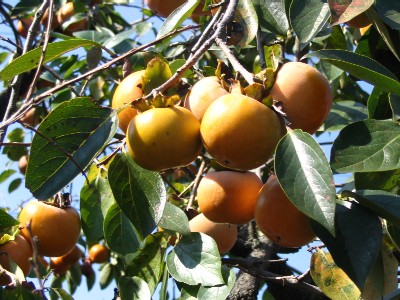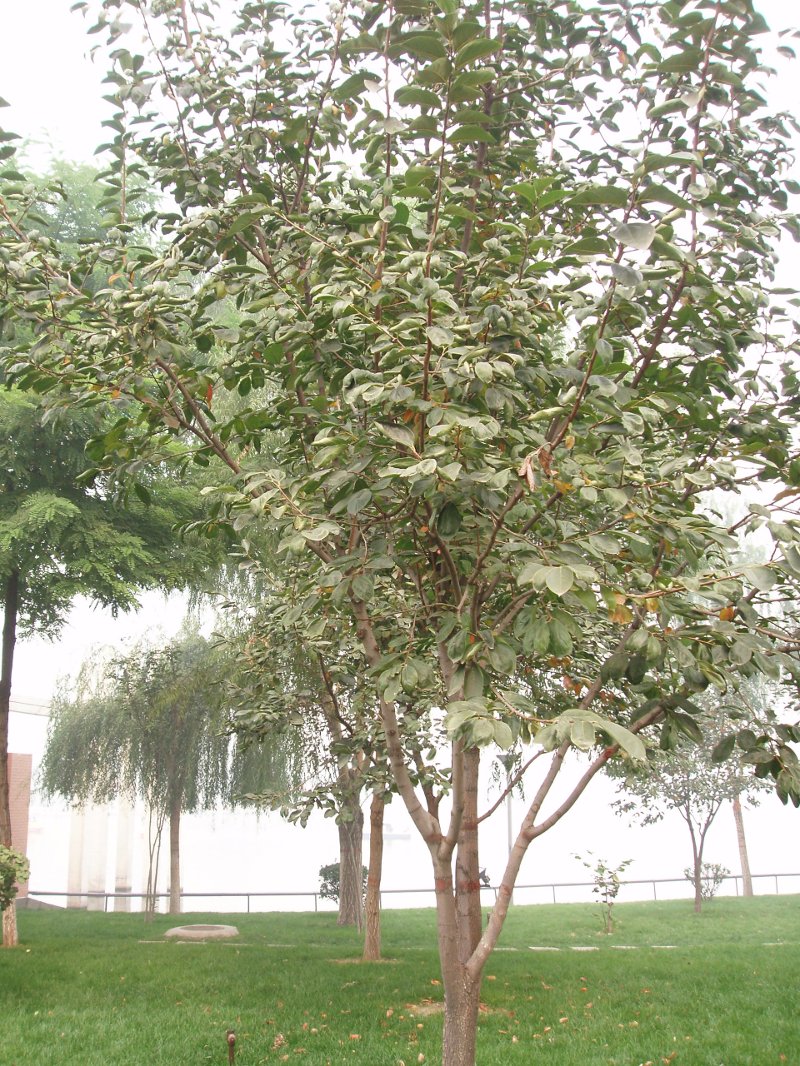Persimmon
Scientific Name: Diospyros kaki
Climate: Temperate
Plant Description: It is a tree, with deciduous leaves, that can reach 18 m. The leaves are 7 - 15 cm long and have an elongated shape with a leathery and shiny appearance above and brown and silky below. The leaves are bluish-green in summer, and in the fall they turn yellow, orange, or red and fall before the fruit ripens. Its fruit, persimmon, is an edible berry with a very sweet flavor, orange to dark red color, tomato-like, bright and fleshy with flattened oval dark brown seeds.
It is native to Asia, the current area of Japan, China, Burma and the Himalayas. In China it is found in the wild at altitudes up to 2,500 m. .
Cultivation: It requires good light and protection from the wind since its wood is brittle, especially in autumn when it is loaded with fruit and its branches can break. It does not tolerate excess moisture in the soil, but is able to live well in dry climates by watering it every few weeks during excessively hot summers.
The persimmon can reproduce by seed, by this method it is not certain that a productive tree will grow. It is better to clone a tree that produces good fruit. For this, any persimmon seed is sown, wait until the tree is about the thickness of a pencil, which can take up to two years, then cut branches of a tree that produce good fruit and grafted into the tree.
The tree needs to accumulate about 100 “cold hours”, which are hours that it passes a temperature below 7 ° C where the tree enters a resting stage before starting to produce new buds and flowers.
Its flowering takes place well into the spring, which helps to minimize the risk of frost that could spoil the harvest.
To be able to bear fruit correctly, it also requires long and hot summers. It is collected in the fall and can even stay on the tree until winter.
 Uses: Persimmon can be consumed in different ways. Direct from the tree when it is well ripened, it is soft and has lowered its astringency.
Uses: Persimmon can be consumed in different ways. Direct from the tree when it is well ripened, it is soft and has lowered its astringency.
The persimmon before ripening is highly astringent and not suitable for consumption, so it must be subjected to a de-astringent treatment, which is achieved by letting it finish ripening in the sun wrapped in paper or stored in a container with a high graduation alcoholic drink, in two or three days the astringency will disappear. It is common to hung and let them dry completely.
Persimmon provides us with Vitamin A and C, potassium, iron, magnesium, calcium and, to a lesser extent, phosphorus and sodium.
Persimmon thanks to the fact that it contains pectin, mucilage and tannins, it is suitable for treating both constipation and diarrhea. The soft and mature one is recommended to treat constipation, while the hard one is to treat diarrhea thanks to its astringent state.
It benefits the vision and the growth and development of the bones. Due to its antioxidant activity, they are believed to decrease the risk of certain degenerative diseases (cancer, cataracts, cardiovascular problems, etc.).
References:
Colaboradores de Wikipedia. (2020a, June 18). Caqui. Wikipedia, La Enciclopedia Libre. https://es.wikipedia.org/wiki/Caqui
colaboradores de Wikipedia. (2020b, June 21). Diospyros kaki. Wikipedia, La Enciclopedia Libre. https://es.wikipedia.org/wiki/Diospyros_kaki
(2012, November 26). Persimón, el caqui inmaduro. Directo al Paladar. https://www.directoalpaladar.com/ingredientes-y-alimentos/persimon-el-caqui-inmaduro
Pau, H. (n.d.). Los muchos beneficios del caqui persimon. Nutridieta. Retrieved July 23, 2020, from https://www.nutridieta.com/kaki-persimon-beneficios/
Persimón el caqui de la denominación de origen Ribera del Xúquer. (n.d.). Persimon. Retrieved July 23, 2020, from http://www.persimon.biz/
Wikipedia contributors. (2020, June 24). Persimmon. Wikipedia. https://en.wikipedia.org/wiki/Persimmon
En español: Caqui

